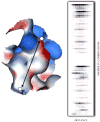Binding affinity prediction with property-encoded shape distribution signatures
- PMID: 20095526
- PMCID: PMC2846646
- DOI: 10.1021/ci9004139
Binding affinity prediction with property-encoded shape distribution signatures
Abstract
We report the use of the molecular signatures known as "property-encoded shape distributions" (PESD) together with standard support vector machine (SVM) techniques to produce validated models that can predict the binding affinity of a large number of protein ligand complexes. This "PESD-SVM" method uses PESD signatures that encode molecular shapes and property distributions on protein and ligand surfaces as features to build SVM models that require no subjective feature selection. A simple protocol was employed for tuning the SVM models during their development, and the results were compared to SFCscore, a regression-based method that was previously shown to perform better than 14 other scoring functions. Although the PESD-SVM method is based on only two surface property maps, the overall results were comparable. For most complexes with a dominant enthalpic contribution to binding (DeltaH/-TDeltaS > 3), a good correlation between true and predicted affinities was observed. Entropy and solvent were not considered in the present approach, and further improvement in accuracy would require accounting for these components rigorously.
Figures






Similar articles
-
Rapid comparison of protein binding site surfaces with property encoded shape distributions.J Chem Inf Model. 2009 Dec;49(12):2863-72. doi: 10.1021/ci900317x. J Chem Inf Model. 2009. PMID: 19919089 Free PMC article.
-
SFCscore(RF): a random forest-based scoring function for improved affinity prediction of protein-ligand complexes.J Chem Inf Model. 2013 Aug 26;53(8):1923-33. doi: 10.1021/ci400120b. Epub 2013 Jun 10. J Chem Inf Model. 2013. PMID: 23705795
-
Characterizing informative sequence descriptors and predicting binding affinities of heterodimeric protein complexes.BMC Bioinformatics. 2015;16 Suppl 18(Suppl 18):S14. doi: 10.1186/1471-2105-16-S18-S14. Epub 2015 Dec 9. BMC Bioinformatics. 2015. PMID: 26681483 Free PMC article.
-
Improving the accuracy of high-throughput protein-protein affinity prediction may require better training data.BMC Bioinformatics. 2017 Mar 23;18(Suppl 5):102. doi: 10.1186/s12859-017-1533-z. BMC Bioinformatics. 2017. PMID: 28361672 Free PMC article.
-
Scoring functions for prediction of protein-ligand interactions.Curr Pharm Des. 2013;19(12):2174-82. doi: 10.2174/1381612811319120005. Curr Pharm Des. 2013. PMID: 23016847 Review.
Cited by
-
Current implications and challenges of artificial intelligence technologies in therapeutic intervention of colorectal cancer.Explor Target Antitumor Ther. 2023;4(6):1286-1300. doi: 10.37349/etat.2023.00197. Epub 2023 Dec 27. Explor Target Antitumor Ther. 2023. PMID: 38213536 Free PMC article. Review.
-
Using diverse potentials and scoring functions for the development of improved machine-learned models for protein-ligand affinity and docking pose prediction.J Comput Aided Mol Des. 2021 Nov;35(11):1095-1123. doi: 10.1007/s10822-021-00423-4. Epub 2021 Oct 28. J Comput Aided Mol Des. 2021. PMID: 34708263
-
Deep Learning in Drug Design: Protein-Ligand Binding Affinity Prediction.IEEE/ACM Trans Comput Biol Bioinform. 2022 Jan-Feb;19(1):407-417. doi: 10.1109/TCBB.2020.3046945. Epub 2022 Feb 3. IEEE/ACM Trans Comput Biol Bioinform. 2022. PMID: 33360998 Free PMC article.
-
Robust scoring functions for protein-ligand interactions with quantum chemical charge models.J Chem Inf Model. 2011 Oct 24;51(10):2528-37. doi: 10.1021/ci200220v. Epub 2011 Oct 7. J Chem Inf Model. 2011. PMID: 21932857 Free PMC article.
-
Support vector regression scoring of receptor-ligand complexes for rank-ordering and virtual screening of chemical libraries.J Chem Inf Model. 2011 Sep 26;51(9):2132-8. doi: 10.1021/ci200078f. Epub 2011 Jul 26. J Chem Inf Model. 2011. PMID: 21728360 Free PMC article.
References
-
- Gehlhaar DK, Verkhivker GM, Rejto PA, Sherman CJ, Fogel DR, Fogel LJ, Freer ST. Molecular Recognition of the Inhibitor AG-1343 by HIV-1 Protease: Conformationally Flexible Docking by Evolutionary Programming. Chem Biol. 1995;2:317–324. - PubMed
-
- Muegge I, Martin YC. A General and Fast Scoring Function for Protein-Ligand Interactions: A Simplified Potential Approach. J Med Chem. 1999;42:791–804. - PubMed
-
- Böhm H-J. The development of a simple empirical scoring function to estimate the binding constant for a protein-ligand complex of known three-dimensional structure. J Comput-Aided Mol Des. 1994;8:243–256. - PubMed
-
- Rarey M, Kramer B, Lengauer T, Klebe G. A Fast Flexible Docking Method using an Incremental Construction Algorithm. J Mol Biol. 1996;261:470–489. - PubMed
-
- Jones G, Willett P, Glen RC, Leach AR, Taylor R. Development and validation of a genetic algorithm for flexible docking. J Mol Biol. 1997;267:727–748. - PubMed
Publication types
MeSH terms
Substances
Grants and funding
LinkOut - more resources
Full Text Sources

